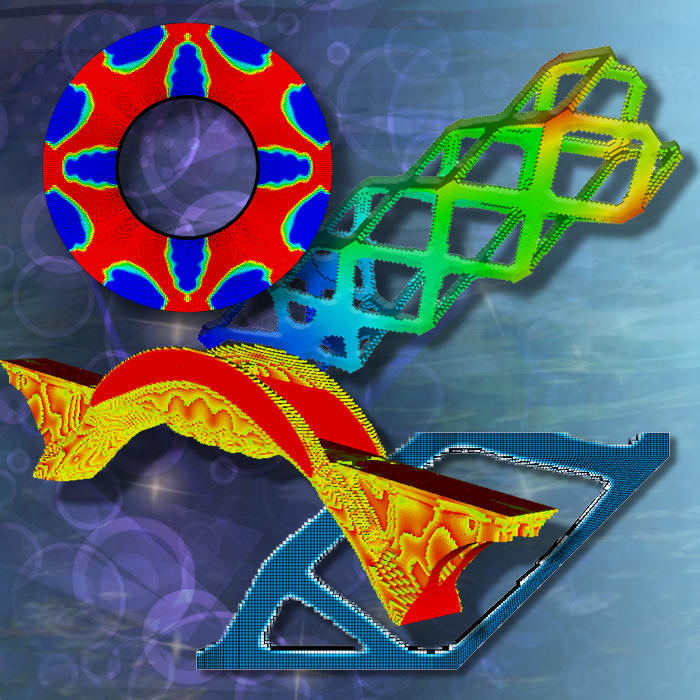Daniel Tortorelli (17-SI-005)
Executive Summary
We are developing an automated design-optimization system for use in additive manufacturing. This automated system will include complex multiphysics simulations to predict material properties, replacing trial-and-error methods with a framework that enables fast, reliable designs that have been optimized for multiple properties in support of stockpile stewardship and other national security missions.
Project Description
Today's additive manufacturing (AM) fabrication technologies enable multi-material microstructure complexities with multifunctional capabilities that were previously unimaginable. Structures with complex micro-architectures of metals, polymers, and ceramics are being created at increasing rates and, in some cases, several different materials are combined to create metamaterials (i.e., materials engineered to have properties not found in nature). These materials can be used to design structures that are stiff and highly conductive with zero thermal expansion, and that have tunable acoustic properties. Formal design paradigms and frameworks do not yet exist, so designs are generated via costly and tedious trial-and-error methods, even though simulation and optimization software is readily available. Our computational design-optimization approach combines simulation and nonlinear programming to optimize a variety of engineering systems at Lawrence Livermore National Laboratory. Design performance will be predicted by complex simulations exhibiting uncertainties, multiphysics, multiple length scales, nonlinearities, and transients. Simulation complexities are compounded by designs that contain complex features that are enabled by AM capabilities. Each of our optimized designs are obtained by defining and solving an optimization problem to minimize a cost function and satisfy a series of constraint inequalities with respect to the design parameters. To address these problems, we use algorithms that iteratively update design parameters until convergence criteria are satisfied. Each iteration requires a simulation of the design to evaluate the optimization cost and constraint functions, as well as a sensitivity analysis to compute the gradients of these functions with respect to design parameters.
Our goal is to combine simulation and nonlinear programming to optimize a variety of engineering systems. We intend to develop algorithms for optimization under uncertainty—that is, optimization problems characterized by the need to make decisions without knowing what their full effects will be—utilizing existing simulation codes. In addition, we will design sensitivity analyses that are computationally efficient, create reduced-order models to aid multi-resolution design and optimization under uncertainty, and develop adaptive mesh-refinement strategies conducive to changing design geometries. We also expect to develop shape representation schemes amenable to design geometry and geometric uncertainty, as well as solvers and pre-conditioners that take advantage of systems with multiple right-hand sides (i.e., mathematical expressions on right-hand sides of equations that represent the system). This methodology will be applied to (1) lattice structures, (2) blast-resistant protection systems, (3) structural electromagnetic devices, and (4) fluid and mass transport applications. Benefits will include improved design performance and reduced development time.
Mission Relevance
By optimizing diverse engineering systems through our efforts to develop algorithms for optimization under uncertainty, our work supports the NNSA's goal of strengthening the science, technology, and engineering base and enhances the Laboratory's high-performance computing, simulation, and data science core competency.
FY17 Accomplishments and Results
In FY17 we (1) developed a new algorithm for nonlinear programming that does not require the direct inversion of a matrix, which was a serious bottleneck towards scalability; (2) implemented this algorithm in a new nonlinear-programming solver software library named HiOp; (3) developed an automated process for creating reduced-order models of periodic structural trusses required for multiscale optimization; and (4) researched methods for decoupling the finite-element mesh from the nonlinear optimization, a required step for adaptive mesh refinement and efficient representation of material variation.
Publications and Presentations
Barbarosie, C. A., et al. 2017. "On Domain Symmetry And Its Use In Homogenization." International Journal of Solids and Structures. (Forthcoming.) LLNL-JRNL-690921.
Ivarsson, N. et al. 2017. "Dynamic Topology Optimization Based on Finite Strain Visco-Plasticity." International Journal for Numerical Methods in Engineering. (Forthcoming.) LLNL-JRNL-739019.
Lian, H., et al. 2017. "Combined Shape and Topology Optimization for Minimization of Maximal von Mises Stress." Structural and Multidisciplinary Optimization 55 (5): 1541—1557. doi: 10.1007/s00158-017-1656-x. LLNL-JRNL-708997.
Najafi, A., et al. 2017. "Shape Optimization Using a NURBS-Based Interface-Enriched Generalized FEM." International Journal for Numerical Methods in Engineering 111 (10): 927–954. doi: LLNL-JRNL-708998.
Petra, C.G. 2017. "A Memory-Distributed Quasi-Newton Solver for Nonlinear Programming Problems with a Small Number of General Constraints." Journal of Parallel and Distributed Computing. (Forthcoming.) LLNL-JRNL-739001.
Salazar, M. and D. A. Tortorelli. 2017. "Adaptive Mesh Refinement in Stress Constrained Topology Optimization." World Congress of Structural and Multidisciplinary Optimization. (Forthcoming.) LLNL-PRES-725039.
——— 2017. "Adaptive Mesh Refinement in Stress Constrained Topology Optimization in 3D." World Congress of Structural and Multidisciplinary Optimisation. (Forthcoming.) LLNL-PRES-731442.
Tortorelli, D. A. and D. A. White. 2017. "Optimal Multi-Functional Design via LLNL's Center for Design and Optimization." (Forthcoming.) LLNL-PRES-730379.
Wallin, M., et al. 2017. "Stiffness Optimization of Non-Linear Elastic Structures." Computer Methods in Applied Mechanics and Engineering 330. LLNL-JRNL-731767.
Wallin, N., et al. 2017. "Dynamic Topology Optimization Based on Finite Strain Visco-Plasticity." World Congress of Structural and Multidisciplinary Optimisation. (Forthcoming.) LLNL-ABS-717640.
Watts, S. E., and D. A. Tortorelli. 2017. "A Geometric Projection Method for Designing Three-Dimensional Open Lattices with Inverse Homogenization." International Journal for Numerical Methods in Engineering 112. doi: 10.1002/nme.5569. LLNL-JRNL-701297.
White, D. A. and M. Stowell. 2017. "Topology Optimization in Fourier Space." World Congress of Structural and Multidisciplinary Optimisation. (Forthcoming.) LLNL-PRES-731031.
White, D. A., et al. 2017. "Topology Optimization in Fourier Space." Structural and Multidisciplinary Optimization. (Forthcoming.) LLNL-JRNL-736779.
   





